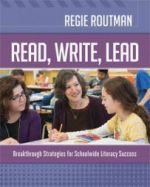10 Surefire Ideas to Remove Writing Roadblocks

So you want to teach writing well. It’s not as hard as you think. Yes, it’s a challenge, but it can be exhilarating.
I believe writing – more than anything we teach – has the power to change students’ lives, for them to see themselves, sometimes for the first time, as smart thinkers and writers across the curriculum. As one student proudly proclaimed when he put research notes into his own words, “I thought groundbreaking thoughts! Hooray for me!”
Come along on a drive with me. Not a drive-by, but a relaxing drive where we slow down and notice the signs that make writing doable, effective, and gratifying. We’ll make some stops along the way, learning how to avoid some common barriers and hazards.
In your travels ahead, despite your best efforts, you will likely make some wrong turns. Don’t despair. There are always alternate routes. Trust yourself, inform yourself, and enjoy the journey. Here are my 10 surefire ideas to pave the way.
 1. See yourself as a writer.
1. See yourself as a writer.
Writing is scary. The blank page or screen calls to us to say something, and often the words don’t come. Come clean with your students. If you hate and fear writing, tell them. If it’s a struggle every time, share that struggle. They will appreciate and admire you for your honesty, and they will relate. You already are a writer. No doubt you have authored some of the following: emails, blogs, messages, tweets, cards, notes, letters, assignments, and more.
2. Write for real-world audiences and purposes.
Writing for audience and purpose is the number one recommendation that encompasses and trumps all the others. Writers write for readers. You already know this even if you haven’t yet gone down this road. Everything you write has a genuine audience even if that audience is yourself, such as in a reflection or journal entry. Or you may write a newsletter where the audience is your students’ families. The point is your audience is real. When students write solely for the teacher or the bulletin board, they don’t invest full effort and energy, and we get lackluster results.
Aim for writing that engages students’ hearts and minds. That engagement will lead to all-out efforts by your students. Look at required curriculum and standards with an eye and effort for real-world connections and student engagement. Ask yourself: “How can I make this writing relevant for students?” “Why does this writing matter?” “Is it worth our time and effort?” “Who are our readers?” Rethink and reroute as needed.
3. Put the writer before the writing.
Ask the writer to read his piece aloud. Just listen for the whole of the piece. Then read it aloud again. Adopt a mindset of strengths and celebrations. Ignore that hazardous warning sign, “needs improvement.” Force yourself – you can do it! – to focus on the writer’s language, message, and intentions. Sit on your hands, if necessary; put aside that pen or red pencil. Ignore spelling and grammar issues – for now. Notice the craft, the risks taken, and all that seems significant for this writer.

I know what you’re thinking. What about all those spelling, punctuation, and grammar mistakes? Observe the stop sign, and save those for last. If the writer leaves a conference feeling deflated, the student’s commitment and energy to go on writing may be lost – and not just for this one piece of writing. Observe the writer’s facial expressions and posture. Ensure your feedback has created the will, support, and confidence to go on writing. And, when you tackle those editing issues later, ensure the writer holds the pencil.
Editing doesn’t matter much if the writing is “correct” but the content isn’t worth reading.
Finally, for efficiency and giving students in-depth feedback, rely on public writing conferences. The whole class listens in to one student’s writing conference and is expected to apply what they learn. Separate content and editing conferences, and do the latter last. Editing doesn’t matter much if the writing is “correct” but the content isn’t worth reading.
4. Expand choice and format.
Remember the last time someone required you to write something to exact specifications. Not much fun, was it? Five-paragraph essays and other rigid formats and formulas are hazardous to writing freely and joyfully. Outside of school, today’s students are used to writing blogs and texts, interacting with social media, and incorporating photos, video, and multi-media in their presentations and writing.
We need to catch up, and at the very least provide some choice and student input within any writing structure we set up for them. Not comfortable with total free choice in writing? Me neither. Adopt choice within structure – choice with some non-negotiables, as in the story that follows.
Regie talks with students who are getting ready to write a memoir
5. Start with stories.
All of us love stories. Stories are what connect us to each other, humanize us, and give us a window into a deeper truth. Students love to hear family stories, their peers’ stories, and our own stories. In a fifth grade classroom, where we were focusing on memoir and students were to write a memoir snippet, that is, choose the most memorable part of one significant life experience and expand on that with elaboration and detail, I shared a precious memory with my grandmother.
See the demonstration video above (or follow this link) for my storytelling to the students before writing. Among other things, I talk about who my audience for the piece is and why and how writers invent dialogue that is emotionally true to their story.
6. Demonstrate your writing process.

If students see us write a perfect piece in front of them, we are taking them down the wrong road.
For your preparation, create ahead of time a skeletal roadmap with the major signposts to prompt your thinking and keep you moving along. I generally use a Post-it or two. Even if you are fearful and lack confidence, do not write the story at home the night before! If students see us write a perfect piece in front of them, we are taking them down the wrong road.

7. Use rubrics judiciously.
Caution sign needed! While students absolutely need to know the criteria by which they and we evaluate their writing, an overreliance on rubrics breaks writing into bits and pieces, encourages superficiality, and sends the message that the presence of individual traits of writing in a piece – such as sentence fluency, organization, and word choice – add up to effective writing.
An overreliance on rubrics breaks writing into bits and pieces and encourages superficiality.
Use rubrics to set expectations but not as a writing program. Also, try this out: After you do your demonstration writing, go back and analyze which traits you included and how you used them. You’ll be surprised. All the traits will be there. The whole really is greater than the sum of its parts.
8. Notice what authors do.
Connect writing with reading. Good writers read a lot, and they read like writers. Especially with a captivating text, they ask themselves something like, “What has this writer done to create this incredible lead, sense of suspense, humor, and so on?”
Through reading aloud, free choice independent reading, examining student exemplars saved from a previous class, and wide reading, guide students to notice the craft of writing – language play, literary language, dialogue, style, and so on – and to try those elements out in their own writing. The next time you are reading a book you love, try reading like a writer.
9. Write short.

My favorite genre for writing short is free verse poetry, which is also a great equalizer for students who struggle. Everyone succeeds, and students love that they can break the usual rules of the road on punctuation, capitalization, format, font, white space, word choice, and more. Writing short gives our students and us energy!
10. Provide sustained time.
Time is our biggest roadblock to writing. None of the ideas discussed will matter much if we don’t make writing high priority and schedule it daily, preferably at the same time. Then ensure that most of that time is given over to students to write uninterrupted, in a peaceful and organized space.
Limit the length of demonstrations and mini-lessons; the main event is students engaged in writing. Use that time to confer with students, either quick 1-3 minute roving conferences and/or a few in depth one-on-one conferences.
Finally, the only way to fit writing in each day is to integrate writing, with reading, into the content areas. Once your students routinely write to think, problem solve, create and explore, writing becomes many students’ favorite subject, and you have a more joyful classroom.
Regie Routman (@regieroutman) is a longtime teacher, author, and speaker who is committed to improving the literacy and learning lives of children, especially those in high-challenge schools. Her professional development series from Heinemann, Regie Routman in Residence, captures the essence of this experience. For further ideas and lessons on writing well, or to contact Regie, visit her website.


































Thanks for the article ——– many students have writers block and need some tools and motivation to over come this barrier. Writing is at the core of our web site = http://www.piclits.com ——- We are about literacy which is founded in writing & reading —— in my op. Thanks for the artilcle
Terry Friedlander, founder ( PicLits.com ) :)
Have students create a rubric, in class discussions, based on a sample of the kind of writing they will try. Focus on how the piece works to engage a reader and lead her through to another understanding or experience the writer is trying to create. Then have them use what they created on their own pieces.
Did you get a chance to explore PicLits and its many uses as a teaching tool and opportunity to engage/involve students in ‘doing’ —– the basics e.g grammar, punctuation, vocabulary, spelling, via sentences, stories, captions, letters, lyrics, quotations, similes and other poetic devices etc.
When time permits, your feedback would be awesome. Check out our FAQ page. It was recently updated to cover more Q&A and offer up video tutorials and links to “Ideas for Using PicLits”.
best – Terry Friedlander, founder ( http://www.piclits.com )
2012 Top ALA site.
Hi Regie, I was privileged to work with you here in Houston (Spring Branch ISD) several years ago and always look forward to hearing your ideas about writing. Now that I am working with individual students as a private tutor, I can attest to the fact that writing can go from being a struggle to being a favorite subject. Your ideas have helped me grow through the years, and I am forever grateful.
Thanks Tammy for your kind words. Great to hear from you and pleased to know you are experiencing much writing success with your students. Bravo! Warm regards, Regie
Thanks for sharing such practical ideas and for including cautions.